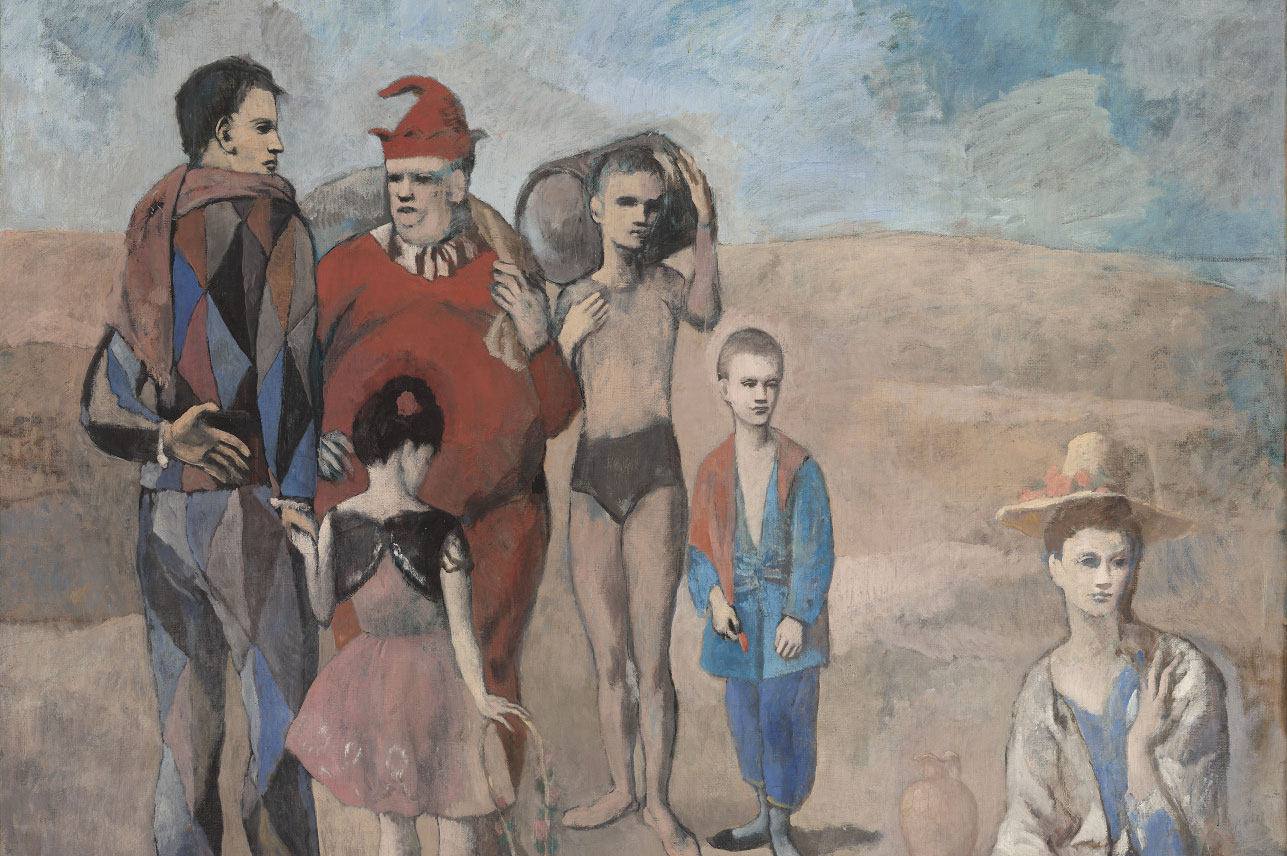
Pablo Picasso, a) Self-Portrait; b) Untitled (Woman Strolling), 1901/1902, a) black chalk and watercolor on wove paper;
b) black chalk on wove paper, Ailsa Mellon Bruce Collection, 1970.17.164.a-b
After shattering representational tradition through cubism, which he developed with Georges Braque, Picasso became the artistic visionary against whom most others measured their creativity throughout the 20th century.
The son of an artist, Picasso attended art schools in his native Spain and in his late teens aligned his sensibilities with bohemian writers and artists in Barcelona and Madrid who opposed Spain’s stalled social hierarchies and conservative culture.
After early work inspired by international models—the anguished, attenuated figures of El Greco, the dark, moody outlines of symbolism, and the sinuous curvatures of art nouveau to name a few—Picasso began to find his own vision. The art he made in the decade between 1905 and 1915 unleashed a torrent of originality—Rose and Blue Period pieces that probe the emotional depths of his personal experiences and identity; masklike portraits and heavily faceted nudes that translate classical and primal aspects of ancient, Iberian, and African cultures, culminating in Les Demoiselles d’Avignon (1907); and the cubist and collage works which, in their fragmentation of illusionism, delivered Picasso’s breakthrough.

Man Ray, Pablo Picasso, 1932, gelatin silver print, Patrons' Permanent Fund, 1995.36.100
Over a long lifetime Picasso was famously productive. In the decades following 1915, he incorporated decorativeness into cubism and explored wide-ranging concepts—especially the erotic abandon espoused by the surrealists—in an astounding array of mediums: costume and theatre design, sculpture, ceramics, prints, watercolors, paintings, and public commissions. In his works on paper Picasso created a trove of prints and drawings in which mythology and the sexy beast Minotaur (his alter ego) figure prominently. He also worked on suites of images exploring the elements of creative practice: the artist’s studio and the relationship of artist and model.
In his last decades Picasso took on the great masters—pitting his print, watercolor, and painted works against signature images by Nicolas Poussin, Louis Le Nain, Diego Velázquez, Rembrandt van Rijn, Édouard Manet, and others—just as artists who followed Picasso would test themselves against his example. Pablo Ruiz Picasso died in 1972 at age 91.
Crépuscule, a poem by Picasso's friend and writer Guillaume Apollinaire
During his early years in Paris Picasso was so close to his writer and poet friends that he penned “Au Rendez-vous des poètes” on the door of his Montmartre apartment. Here, the poem Crépuscule (Twilight) by Guillaume Apollinaire, poet and writer as well as Picasso’s friend, artistic champion, and fellow spectator at performances of the Cirque Medrano.
Brushed by the shadows of the dead
On the grass where day expires
Columbine strips bare admires
her body in the pond instead
A charlatan of twilight formed
Boasts of the tricks to be performed
The sky without a stain unmarred
Is studded with the milk-white stars
From the boards pale Harlequin
First salutes the spectators
Sorcerers from Bohemia
Fairies sundry enchanters
Having unhooked a star
He proffers it with outstretched hand
While with his feet a hanging man
Sounds the cymbals bar by bar
The blind man rocks a pretty child
The doe with all her fauns slips by
The dwarf observes with saddened pose
How Harlequin magically grows
Translation by A. S. Kline (c) 2002 All Rights Reserved
_______________________________________
Frôlée par les ombres des morts
Sur l'herbe où le jour s'exténue
L'arlequine s'est mise nue
Et dans l'étang mire son corps
Un charlatan crépusculaire
Vante les tours que l'on va faire
Le ciel sans teinte est constellé
D'astres pâles comme du lait
Sur les tréteaux l'arlequin blême
Salue d'abord les spectateurs
Des sorciers venus de Bohême
Quelques fées et les enchanteurs
Ayant décroché une étoile
Il la manie à bras tendu
Tandis que des pieds un pendu
Sonne en mesure les cymbales
L'aveugle berce un bel enfant
La biche passe avec ses faons
Le nain regarde d'un air triste
Grandir l'arlequin trismégiste







